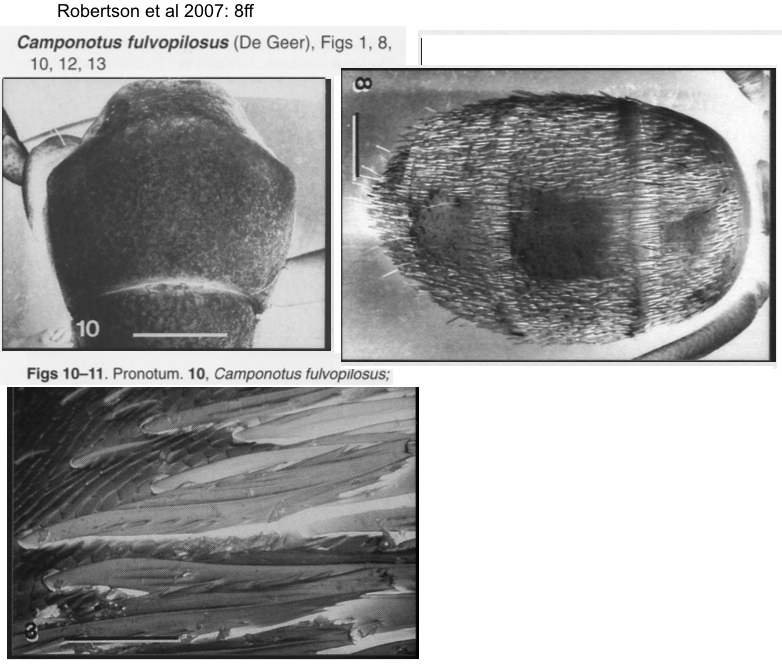Camponotus (Myrmopiromis) fulvopilosus (De Geer)
  Type location South
Africa (Formica fulvo-pilosa, De Geer, 1778: 613,
illustrated, worker; Forel, 1879a: 108, major; Forel, 1910f: 25,
male; Arnold, 1924: 737, queen) from Cape of Good Hope, collector M.
Sparrman - no type images on Antweb (September 2014) Type location South
Africa (Formica fulvo-pilosa, De Geer, 1778: 613,
illustrated, worker; Forel, 1879a: 108, major; Forel, 1910f: 25,
male; Arnold, 1924: 737, queen) from Cape of Good Hope, collector M.
Sparrman - no type images on Antweb (September 2014)
junior synonyms
pilosa (Formica pilosa,
Olivier, 1792: 498, worker) South Africa, Cape of Good Hope
(seemingly the De Geer specimen)
rufiventris
(Formica rufiventris, Fabricius, 1804: 409, worker) South
Africa, Cape of Good Hope - no type images on Antweb (September 2014)
detritoides (Camponotus fulvopilosus De Geer
var. detritoides n.
var., Forel, 1910f: 25, worker) South
Africa, Glatkop, Klein-Namaland, L. Schultze - see http://www.antweb.org/specimenImages.do?code=casent0910452
flavopilosus (Camponotus
fulvopilosus Fabr. var. flavopilosus
n.
var., Emery,
1895h: 54, worker; Forel, 1910f: 25, male; Santschi, 1930b: 78,
queen) Namibia, De Aar - see below
all forms known (see Bolton, 1995)  . .
|
 De Geer's (1778) description is at De Geer's (1778) description is at  . Fabricius's (1804) description of rufiventrisis
at . Fabricius's (1804) description of rufiventrisis
at  .Lepeletier de Saint-Fargeau (1835: 213)
gave a description, this is at .Lepeletier de Saint-Fargeau (1835: 213)
gave a description, this is at  . Forel's (1879a) description of the major
is at . Forel's (1879a) description of the major
is at  . Olivier's (1792)
description of pilosa
is at . Olivier's (1792)
description of pilosa
is at  . Emery's (1895h) note on
flavopilosus was simply that the gastral pilosity
was pale yellow. Similarly, Forel's (1910f) separation of detritoides seems trivial. Arnold
(1924: 736, 740) gave a translation, plus the
description of the queen; these are at . Emery's (1895h) note on
flavopilosus was simply that the gastral pilosity
was pale yellow. Similarly, Forel's (1910f) separation of detritoides seems trivial. Arnold
(1924: 736, 740) gave a translation, plus the
description of the queen; these are at  and and  . .
|
 Robertson &
Zachariades (2007) modern description is at Robertson &
Zachariades (2007) modern description is at  . The montage is adapted
from their original by inverting the monochrome images and, so, giving
a somewhat more real impression of the dorsal pronotum, the dorsal
gaster and the gastral hairs. . The montage is adapted
from their original by inverting the monochrome images and, so, giving
a somewhat more real impression of the dorsal pronotum, the dorsal
gaster and the gastral hairs.
|
 The
photomontage is
of worker polymorphism of specimens collected from
South Africa, Elandskrans, Western Cape, S x°x'x" E y°y'y"; z m; Sam
Danflous, 16.xii.2007; nest under a stone. The
photomontage is
of worker polymorphism of specimens collected from
South Africa, Elandskrans, Western Cape, S x°x'x" E y°y'y"; z m; Sam
Danflous, 16.xii.2007; nest under a stone.
Full images of each morph and others from Namibia can be seen on Workers
|
 Photographs
taken in the field by Dr Brigitte Braschler, at the Grootkop Nature
Reserve next to Oudtshoorn in the Western Cape Province, South Africa,
13.x.2006. [Dr Brigitte M. Braschler, DST-NRF Centre of Excellence for
Invasion Biology, Department of Botany and Zoology, Stellenbosch
University, South Africa] Photographs
taken in the field by Dr Brigitte Braschler, at the Grootkop Nature
Reserve next to Oudtshoorn in the Western Cape Province, South Africa,
13.x.2006. [Dr Brigitte M. Braschler, DST-NRF Centre of Excellence for
Invasion Biology, Department of Botany and Zoology, Stellenbosch
University, South Africa]
|